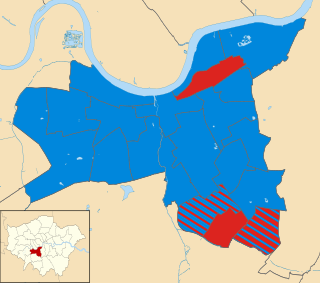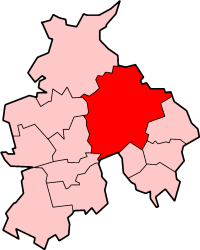Related Research Articles
The election of councillors to Allerdale Borough Council in Cumbria, England took place every four years. The council was established in 1974 and it was abolished in 2023. The last elections were in 2019.

Fylde Borough Council elections are held every four years to elect councillors to Fylde Borough Council in Lancashire, England. Since the last boundary changes in 2023 the council has comprised 37 councillors, representing 17 wards, with each ward electing one, two or three councillors.
Cornwall Council in England, UK, was established in 2009 and is elected every four years. From 1973 to 2005 elections were for Cornwall County Council, with the first election for the new unitary Cornwall Council held in June 2009. This election saw 123 members elected, replacing the previous 82 councillors on Cornwall County Council and the 249 on the six district and borough councils. In June 2013 the Local Government Boundary Commission for England announced a public consultation on its proposal that Cornwall Council should have 87 councillors in future.
Forest Heath District Council in Suffolk, England was elected every four years. between the last boundary changes in 2003 and the final elections in 2015, 27 councillors were elected from 14 wards. The council was abolished in 2019, with the area becoming part of West Suffolk.
Knowsley Metropolitan Borough Council elections are generally held three years out of every four, with a third of the council being elected each time. Knowsley Metropolitan Borough Council, generally known as Knowsley Council, is the local authority for the metropolitan borough of Knowsley in Merseyside, England. Since the last boundary changes in 2016, 45 councillors have been elected from 15 wards.
Half of Adur District Council in West Sussex, England is elected every two years. Until 2003, the council was elected by thirds. Since the last boundary changes in 2004, 29 councillors have been elected from 14 wards.
Fenland District Council in Cambridgeshire, England is elected every four years. Since the last boundary changes in 2023, the council has comprised 43 councillors representing 18 wards, with each ward electing one, two or three councillors.
St Edmundsbury Borough Council in Suffolk, England, was elected every four years. After the last boundary changes in 2003, 45 councillors were elected from 31 wards. The council was abolished in 2019, with the area becoming part of West Suffolk.
East Devon District Council is the local authority for East Devon in England. The council is elected every four years. Sixty councillors are elected from 30 wards since the last boundary changes in 2019.
North East Derbyshire District Council elections are held every four years. North East Derbyshire District Council is the local authority for the non-metropolitan district of North East Derbyshire in Derbyshire, England. Since the last boundary changes in 2019, 53 councillors have been elected from 24 wards.

South Ribble Borough Council elections are held every four years. South Ribble Borough Council is the local authority for the non-metropolitan district of South Ribble in Lancashire, England. Since the last boundary changes in 2015, 50 councillors have been elected from 23 wards. The next borough council elections are due to take place in 2027 as part of the wider 2027 United Kingdom local elections.
Dover District Council is the local authority for the Dover District in Kent, England. The council is elected every four years.

The Council of the Isles of Scilly is a sui generis local government authority covering the Isles of Scilly off the west coast of Cornwall, England. It is currently made up of 16 seats, with all councillors being independents. The council was created in 1891 as the Isles of Scilly Rural District Council and was renamed in 1974.

The Isles of Scilly are a small archipelago off the southwestern tip of Cornwall, England, United Kingdom. One of the islands, St Agnes, is over four miles further south than the most southerly point of the British mainland at Lizard Point.

The 2006 Wandsworth Council election took place on 4 May 2006 to elect members of Wandsworth London Borough Council in London, England. The whole council was up for election and the Conservative Party stayed in overall control of the council.

Ribble Valley Borough Council elections are held every four years. Ribble Valley Borough Council is the local authority for the non-metropolitan district of Ribble Valley in Lancashire, England. Since the last boundary changes in 2019, 40 councillors have been elected from 26 wards.
Local elections were held in Waveney district every four years to elect councillors to Waveney District Council. In the past, one-third of councillors were elected each year, but in 2010 the council opted to change to a whole council election system. Since the last boundary changes in 2002, 48 councillors have been elected from 23 wards. The district was merged with Suffolk Coastal in April 2019 to form East Suffolk, meaning that the 2015 elections were the final Waveney elections to be held.

Islington London Borough Council in London, England is elected every four years. Since the last boundary changes in 2022, 51 councillors have been elected from 17 wards.
Isle of Wight Council is the local authority for the Isle of Wight, a unitary authority and non-metropolitan county in England. Since the last boundary changes in 2021 the island has been divided into 39 electoral divisions, each of which elects one councillors. Elections are held every four years.

The 2019 South Kesteven District Council election took place on 2 May 2019 to elect members of South Kesteven District Council. This was on the same day as other local elections. The entire council was up for election. The incumbent Conservatives lost 5 seats and UKIP lost 1, while independents gained 5 and the Liberal Democrats gained 2. Two wards did not hold a vote, as an equal number of candidates ran as seats available.
References
- ↑ "Elections". Council of the Isles of Scilly. Retrieved 19 April 2016.
- ↑ The Isles of Scilly Order 1978 (Statutory Instrument 1978/1844, 5(1)). UK Parliament. 14 December 1978.
- ↑ "Local Elections Archive Project — St Mary's Ward". www.andrewteale.me.uk. Retrieved 29 May 2022.
- ↑ "Local Elections Archive Project — Bryher Ward". www.andrewteale.me.uk. Retrieved 29 May 2022.
- ↑ "Local Elections Archive Project — St Mary's Ward". www.andrewteale.me.uk. Retrieved 29 May 2022.